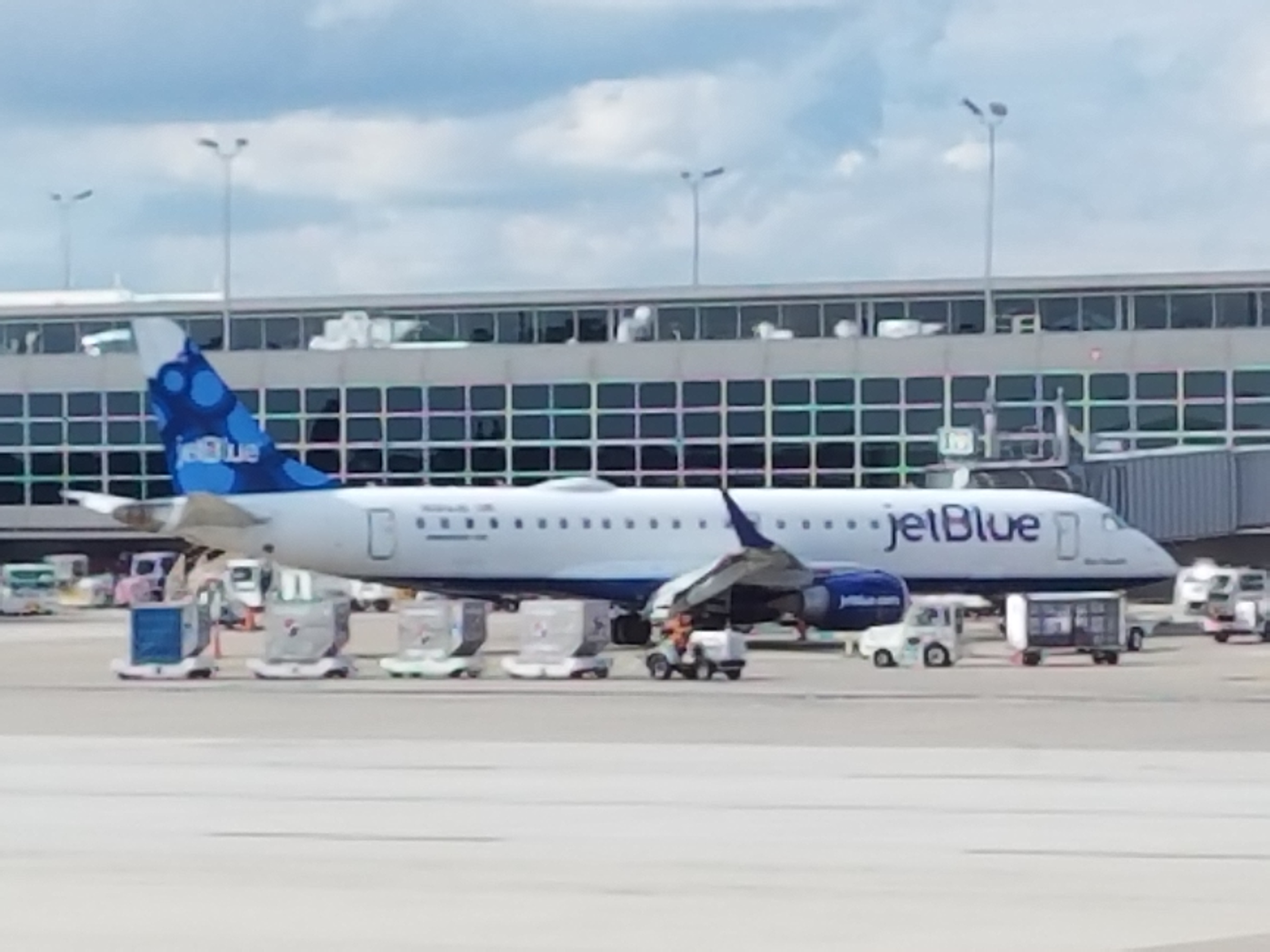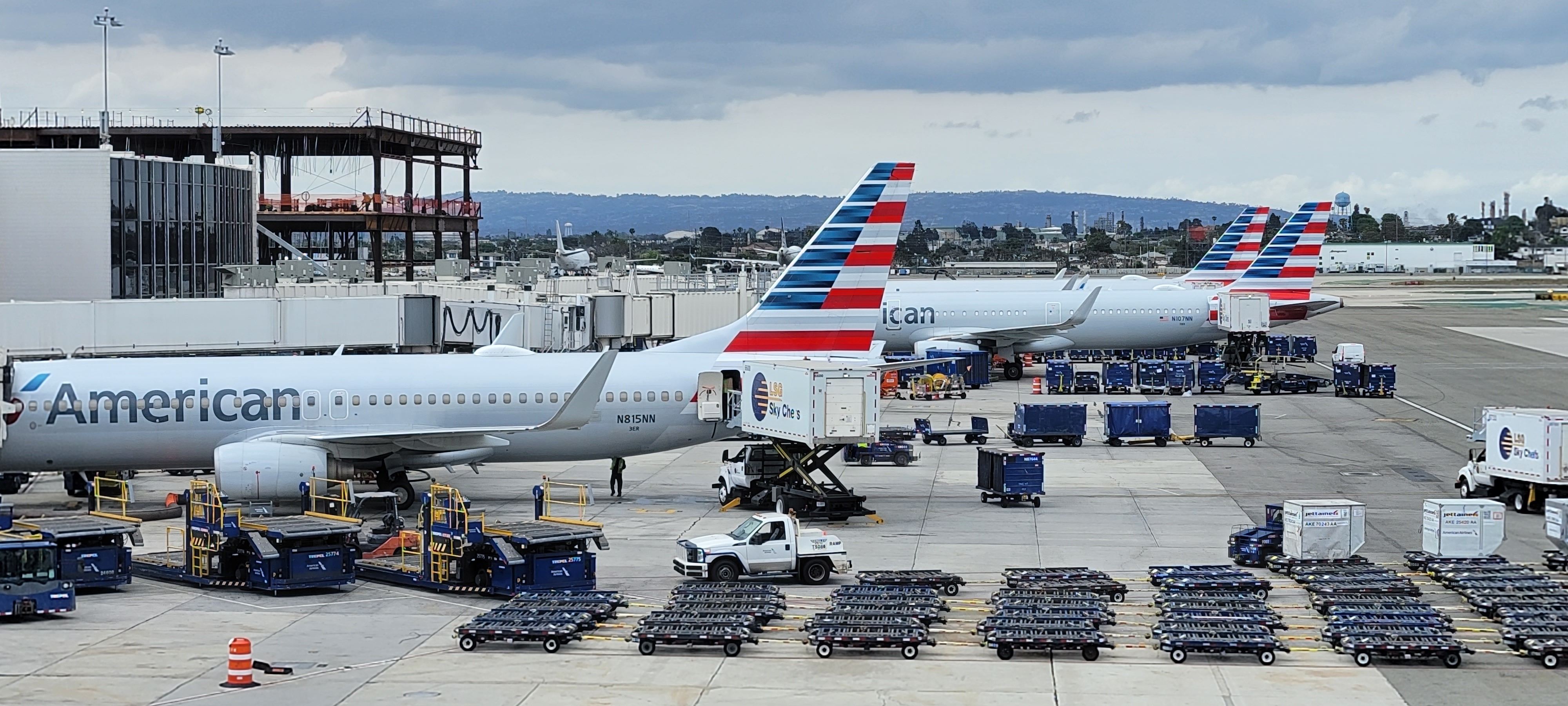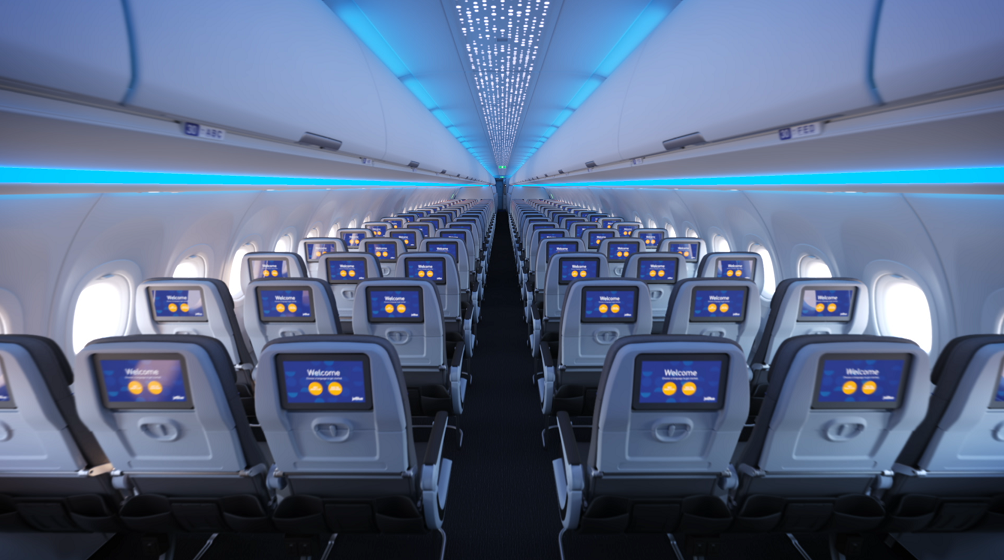American Airlines and JetBlue had a fantastic partnership that allowed customers to earn miles and have reciprocal elite benefits when flying the partner airline. This made them a real competitive force in New York. While the deal had been approved by the federal government in 2020, it was opposed in 2021 – and ultimately beaten in court.
The end of the partnership has been bad for customers, and bad for American and JetBlue which are in a tough spot trying to compete against Delta and United in New York. Neither one can grow there, and both are too small on their own to really matter.
There’s a chance that they could try to re-start the partnership that was dismantled last year. Both carriers say that they want this.

American/JetBlue Partnership Is Good For Passengers, Competition
The Northeast Alliance really was the best plan for marketplace relevance for both American and JetBlue, for the customers of both airlines, and even for customers of United and Delta in the Northeast who would have benefited from their carriers facing a more vibrant competitor. Instead, we’ve seen American mostly ignore the Northeast in favor of the Sunbelt and JetBlue cutting flights as it tries to stem losses.
- The number of slots at New York JFK and LaGuardia are fixed. Regardless of the number of airlines in the market, and both American and JetBlue were among smaller players, the partnership did not reduce the number of flights. It may have shifted who flew which flights, but the total number of flights were the same.
- The partnership increased the supply of seats in the market which tends to lower prices. American and JetBlue had to give up slots to get Trump administration’s approval for the deal and would have had to give up more slots if they did not increase seat capacity. The two airlines accomplished that through increase of gauge. In other words, bigger planes. While the number of slots are fixed, this deal meant more seats per slot. Without the deal, you get fewer seats and higher prices.
American and JetBlue partnering was good for consumers. It created a third viable competitor in New York. Customers benefited, from mileage accrual and redemption to reciprocal elite benefits. That meant AAdvantage status members getting extra legroom seats and bags free on JetBlue (and vice versa). The government took that away.
The Lowest Level Court Made A Weird Decision
After the federal government approved the American-JetBlue partnership, it sued to stop it. The only difference was the party in power. That’s not how rule of law is supposed to work.
The Department of Justice prevailed against the partnership at the federal district court level. American continued to appeal, JetBlue did not. JetBlue preferred to focus on their acquisition of Spirit Airlines, which was a weird choice since they only really needed Spirit’s planes and pilots because of the growth that American partnership represented. JetBlue was operating a lot of American slots out of New York, and they didn’t have the capacity to bulk up Boston, too.
The district court judge’s decision was weird. Traditional anti-trust law looks at consumer benefit or harm. The judge ruled that the partnership was per se illegal because it allowed the two airlines to coordinate who flew which routes. His ruling acknowledged growth in New York as a result of the NEA and also that “American’s slots at JFK and LaGuardia have been used more heavily and efficiently” as a result of the NEA. Both are good for consumers!
However, the judge expressly said that a partnership like American’s with Alaska Airlines would have been fine. However, the injunction in place from that ruling prevents them from doing any kind of partnership with JetBlue, not just restarting the Northeast Alliance.
American Is Still Appealing The Ruling
In June, American Airlines told an appeals court that they still want to go forward with a JetBlue partnership. While that was necessary to rebut the argument that their appeal wasn’t ripe for adjudication, presumably the lawyers were representing the actual position of the airline (it would be very problematic for them if they were not).
In fact, at American Airlines Investor Day airline CEO Robert Isom said that “if there’s an opportunity down the road to partner with JetBlue] we’ll take it.”
American Airlines needs a New York partnership because government slot controls prevent them from growing. As former Chief Commercial Officer Vasu Raja used to say, American is ‘too small to win, too big to walk away’ in the New York market.
And without enough size in New York they aren’t relevant to New York consumers, not just for flights but for co-brand credit card wallet share. The value of their credit card deal rises or falls with their ability to attract spend in this important market.
Notable, American’s pilot union, though not in a decision-making role, now supports the partnership.
“By restricting partnerships, regulatory agencies have bolstered the Delta and United duopoly in NY,” said APA spokesman Dennis Tajer in an interview. “A broader New York partnership, underpinned by metal neutral service by American and JetBlue, would better serve passengers and employees while creating increased competition.
“Right now, Delta and United have a government provided shield of protection from loyalty competition, at a time when loyalty programs are wildly more valuable than they were a year or two ago, as reflected in the financial results for each of them,” Tajer said.

JetBlue Wants Back Into The Partnership
On the JetBlue third quarter earnings call, airline President Marty St. George acknowledged that one of the major holes in the carrier’s strategy is lack of partnerships. They’re looking at partnering and “It certainly could be with American.” Although if not American, then someone else.
So I’m cautiously optimistic that we might have an opportunity at some point in the future. It’s not a gigantic number that’s going to make this plan pivot, but I think it’s certainly one of the tools that could be in the toolbox to try to achieve JetForward. Now second thing is with respect to speed, I think it’d be too early to say. I think it depends on what the structure of the partnership is, but we have a lot of experience at this, and I’m — it will be the appropriate speed for whatever size partnership we choose.

What Would It Take To Do A New Partnership?
If American Airlines wins its appeal, the two airlines would be free to partner. Otherwise they need to go to the government first, even though a partnership that looks more like the American-Alaska deal was explicitly considered permissible by the judge in their case.
However there’s some possibility that the outcome of the election on Tuesday would matter here, too, since the original deal was approved by the Trump Department of Transportation and only opposed once the Biden administration took office.
That’s not dispositive with respect to what position a future administration would take, regardless of which candidate wins.
A Harris administration, for instance, might recognize that subsequent events left United and Delta in a stronger position in New York while hindering overall competition, and that prosecuting JetBlue’s acquisition of Spirit successfully has left Spirit on the brink of bankruptcy. Meanwhile, the Biden DOT has seen this and approved the Alaska acquisition of Hawaiian. Hawaiian was a financially weak player and this strengthens them for continued competition.
American had planned to sponsor JetBlue for membership in oneworld. That’s an alternative universe that would really benefit JetBlue customers, but that could still wind up in our future.


A future partnership will eventually lead to B6 and AA coming together. B6 can’t survive on its own. AA doesn’t have the financials to acquire B6 fully, but it can do so with the help of Private Equity and it will happen, eventually, and solve their respective challenges in NYC. There is no way DL can acquire B6 given its outsized presence in NY and BOS, where it overlaps with B6. Same goes for UA, which would have difficulty given its EWR hub.
The synergies between AA and B6 are undeniable, both operationally, but also would allow AA to transform itself into a carrier that can unbundle and sell premium, if it borrows a page from the B6 playbook for a change and stops running itself like the old US.
the arrogance of this phrasing is stratospheric . disgusting
Write in plain language. That is the real mark of an intellectual.
@SFO/EWR – I wrote this sitting on a delayed flight, maybe I could have been clearer but a brief review of your comments reveals why you’re so quick to offer commentary on so many posts.
My writing can often be stream of consciousness, and no doubt a good editor would add value, but you might consider not trolling so often?
@SFO Geez, who pissed in your soup?
@ Gary — A few million cash to the Orange Blob should seal the deal.
You don’t get it, Gary.
The Dept. of Transportation approved the AA/B6 slot use proposal. AA and B6 did not get approval for antitrust immunized capacity planning and revenue sharing. That type of arrangement is granted by the Dept. of Justice which sued to block the NEA.
The trial judge said that AA/B6 could have had a simple codeshare arrangement without revenue sharing or joint capacity planning – just as AA has with AS. If AA wants to lease slots to B6, they can but the DOJ still might intervene if the size of the transaction is large enough.
US gave away 1/4 of the slots at JFK and had as many slots at JFK as DL did when B6 was created. AA told the government post 9/11 that slots should be removed in order to improve on-time. Delta added flights every chance it could, including when the FAA removed slot controls at LGA and JFK – which is how DL became the largest slot holder at both JFK and LGA even without having a majority of slots, unlike AA at DCA or UA at EWR when that airport was slot-controlled.
AA simply has not known how to win in competitive markets; that can be seen in Chicago and Los Angeles even where slots aren’t the issue. B6 can’t execute on what should have been a solid product and, lo and behold DL has overtaken them in both JFK and BOS.
AA and B6 COULD entertain a partnership similar to AA/AS tomorrow. It has nothing to do with the political party at the WH.
The Northeast Alliance was good for both American Airlines and JetBlue Airways. The answer to whether they have a reasonable chance to have an alliance may be answered on Tuesday or later in the week. I doubt that a merger of the two would be approved at this time or any time while they are as strong as they still are. Such a merger would signal that United Airlines and Delta Airlines should seek smaller partners to merge with, further consolidating the airlines in the USA.
Let’s hope ScaMala wins to keep the big airlines from squatting on anymore New York slots.
“The only difference was the party in power. That’s not how rule of law is supposed to work.”
Tell that to the ladies miscarrying in red states who are dying in the ERs because their states won’t allow doctors to help them. What was law of the land for 50 years is no longer. Get used to it.
I honestly doubt Jetblue will get there deal because why would anybody want to travel to *Woke* Washington
AA keeps outsourcing its flying and focusing on DFW/CLT/PHL and then complains that it cannot win the large markets…they used to make this their differentiation trying to find the next NYC. they failed miserably in Austin oh and btw they even had slots at JFK they werent even using which probably sealed their fate in this case. Until they make a choice to focus on JFK versus PHL (or ideologically USAir/AW versus AA) they will continue in the same death spiral of poor management and shrinking at major markets. This America West board has run its course and needs to go for AA to get back to being a real airline.
I thought Tim Dunn was nuts, but SFO/EWR is a looney toon.
America West Board??! Really? Most of the AWA folks are all gone. It will be 20 years since AWA surrendered their FAA certificate in May 2025.
Here’s the problem with AA as I see it:
Our Chairman is an ex-EVP of finance and 30 year career Boeing guy! All AA employees work for Boeing. And one only had to look at the Boeing strike to see what an anti-labor company that is. This is why perfectly good (and many newer) A330s were parked while full lease rates paid…350 order cxl…..737-10 Maxes ordered (good luck with those) when UAL cxl.
AA’s biggest problem is they let a fox into the chicken coop in terms of Boeing being on and controlling the Board of Directors. Isom’s bosses. The buck stops there. Finance guy AND ex-Boeing guy making the decisions or at least strongly influencing those decisions in senior AA management is a recipe for bad decision-making. Anyone think Isom is gonna champion ordering 350s with the Boeing ex-EVP as his boss? Not freaking likely if he wants to keep his job.
It’s no wonder that AA has gone from largest to a distant 3rd place amongst the big 3. Sad too. Boeing dysfunctional mgmt = AA dysfunctional mgmt.
PS – I fly Boeings. I like the plane. I like Airbus too – but it’s just business to keep your options open and AA management can’t do that as evidenced by the bad decisions of parking the A330, cxl the 350 and ordering a probably never built 737-Max 10!
Tim Dunn wouldn’t know antitrust law if it walked up and smacked in the face. I rarely agree with Gary, be he is 100% correct that the lower court got the law wrong.
AA will win the appeal. I’m willing to bet on it. Not waffle like Tim. Whenever something doesn’t turn out the way Tim likes, he changes what he claims he said, or he distorts “facts”.
“Smacked *him* in the face.”
Tim,
US had very few slots at JFK to begin with, pre-merger. What happened there is that they, and AA seem to have lost track of what they had but US’s JFK slots pre-merger were not going to make or break AA at JFK.
“AA and B6 COULD entertain a partnership similar to AA/AS tomorrow. It has nothing to do with the political party at the WH.”
Except that it does, “Tim”. The prior administration approved it. And yes, the DOT approves that sort of thing. All the DOJ can do is not sue. They don’t “approve”, they just don’t sue.
It was only under the following administration that the NEA was sued.
Learn some facts.
It may not hold up under appeal, but the DOJ picked the court where they thought they had the best chance of winning. That doesn’t mean much about legality, just that the DOJ sued in the district they thought they’d most likely win the first action.
The appeal is where we learn more about legality of the NEA.
My goal is to see B6 destroyed. Being purchased by AA would be the fastest and easiest way it can happen given what happened to TWA.
US had 1/4 of the slots at LGA. That is not immaterial.
the DOT DID NOT approve the antitrust immunized joint venture because that is not within their authority to approve, they knew it, and anyone with a half brain of intelligence WHICH DOES NOT INCLUDE YOU knows it.
an antitrust immunized joint venture of two domestic airlines will not fly.
under any administration.
All depends who wins this coming Tuesday. ==;-)
As I understand it (which could be totally wrong) the judge enjoined JetBlue and American from any kind of cooperation. That’s much of what American is appealing. What’s confusing to me is that many of the judge’s comments suggested that a simple code share arrangement would pass muster. But that wasn’t what he ultimately ruled. I’d appreciate any corrections or additions that are substantiated with sound evidence.